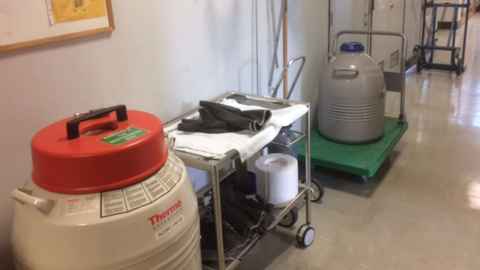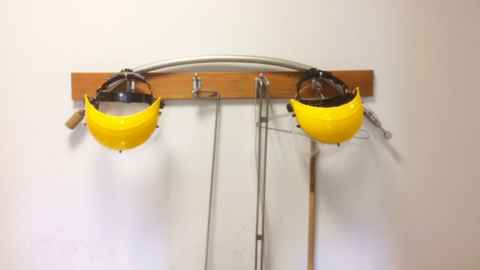Cryogenic safety
Cryogenic materials at the University can cause serious harm if not handled correctly. Learn about the hazards and how to protect yourself and others.

The University’s Safe Methods of Use (SMOU) explain the hazards and appropriate actions you should take.
Quick reference: Safe methods of use
This is an outline of the University’s SMOUs for cryogenic materials. For the full version, download the SMOU 18 Cryogenic Liquids and SMOU 21 Safe Storage of Liquid Nitrogen from our dedicated Safe Methods of Use page.
Burns
Cryogenic liquids are extremely cold. Contact with exposed skin can produce a painful burn. A splash to the eye can cause permanent
damage to the eye and blindness.
Personal protective equipment
You should wear:
- A face shield
- Loose-fitting thermal mittens or heavy gloves (that can be easily shaken off)
- Closed shoes or boots.
- Note that if you are pouring cryogenic fluids while wearing gum boots, make sure your pants are not tucked into your boots.
Emergency treatment
- Try to raise the burnt area to room temperature reasonably quickly
- Do not use warm water
- Do not remove clothing around burn. This may lift frostbitten skin.
Asphyxiation
Cryogenic liquids will expand many times their original volume when they convert to gas at room temperature.
If vented into a closed space, cryogenic liquids such as helium, argon and nitrogen can displace oxygen when they become gaseous. In closed rooms, this can create potentially dangerous oxygen-deficient environments, especially as the victim will have no warning that they are in or entering an oxygen-deficient environment.
For this reason:
- Containers of cryogenic liquid must never be stored in small
enclosed rooms - Liquid nitrogen and argon (where the gas is heavier than air) must never be stored or used in basement areas or pits where gas can accumulate and develop an oxygen-deficient atmosphere.

Other hazards
Pressure build-up
Boiling of liquefied gases within a closed system increases pressure.
- Make certain that cryogenic liquids are never contained in a closed system.
- Cold fingers and similar devices have exploded when either an ice dam is formed within the apparatus or when a closed system is created by shutting off all valves.
- Users should tape exposed glass parts to minimise flying glass shards in an explosion.
Oxygen enrichment
Liquid nitrogen and liquid helium may fractionally distill air, causing liquid oxygen to collect in the cryogenic container.
Liquid oxygen increases the combustibility of many materials, creating potentially explosive conditions.
- Make sure to provide adequate venting when working with cryogenic liquids in a closed system or enclosed space.
Embrittlement
Materials exposed to cryogenic temperatures for long periods or have undergone periodic warming and freezing must be examined regularly for cracks and warping.
- Do not dispose of cryogenic liquids down the drain. Ordinary materials such as metal or polyvinylchoride (PVC) piping in laboratory sinks may not be able to withstand cryogenic temperatures.
- Allow cryogenic liquids to evaporate in a fume hood or other well-ventilated area.
Cryotube explosions
Cryotubes used to contain samples stored under liquid nitrogen may explode without warning when warmed. Tube explosions are caused by liquid nitrogen entering the tube through minute cracks and then expanding rapidly as the tube thaws.
- Thaw tubes behind shields or in fume hoods where the glass sash can provide shielding.
Important information: Protect yourself from cryotube explosions
When thawing cryotubes in the open, it is essential that you take the following steps:
- Wear a face shield, or at least safety goggles, whenever handling cryogenic liquids
- Wear heavy gloves.
Transporting liquid nitrogen in lifts
Liquid nitrogen must travel unaccompanied in a lift.
- Transport of liquid nitrogen should take place outside of peak times (when the lift is not being used by others).
- Two people should work together to transport liquid nitrogen via the lift. One person must be stationed on the relevant floor to receive the liquid nitrogen when the lift arrives.
- Liquid nitrogen must not be carried up and down stairwells.